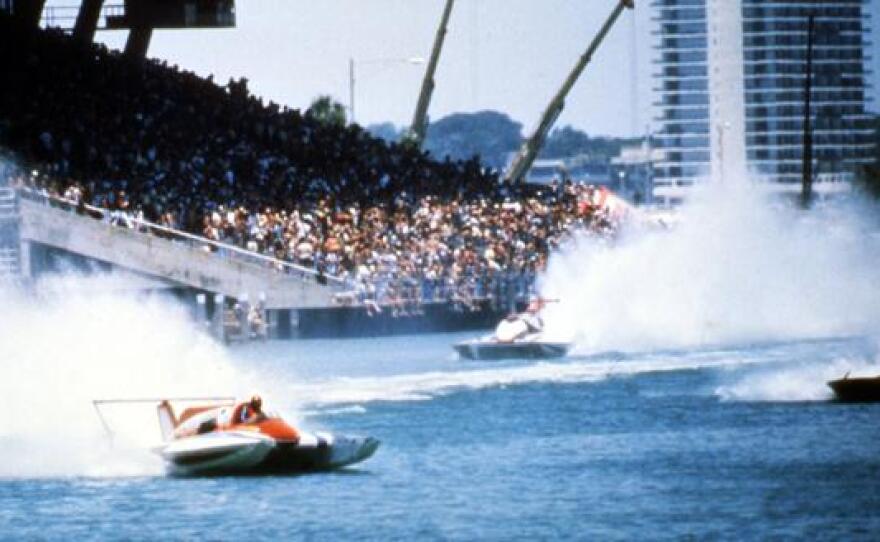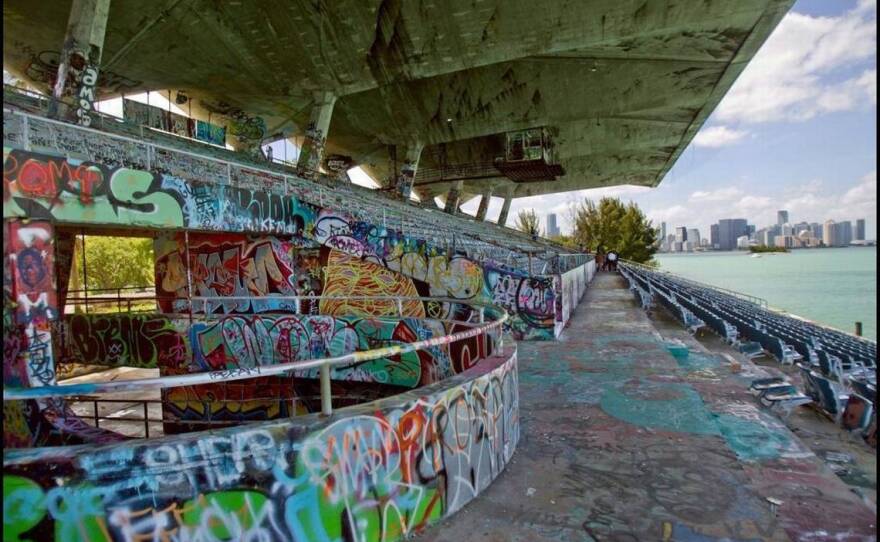Cultural landmarks around the City of Miami find themselves in limbo. Theaters and community spaces are closed and face expensive repairs. In WLRN's four-part series, Culture of Neglect, we're shining light on what our community leaders are doing — or not doing — to restore these long-standing institutions. The series will run online and on air Monday through Thursday.
When Miami Marine Stadium opened in 1963, it represented a new era for the growing city. A wave of Cuban refugees was rapidly transforming the city’s population, and one of those refugees, a 28-year-old Cuban architect Hilario Candela, designed the concrete building.
The city-owned venue had 6,000 seats facing toward the water with an unobstructed view of downtown Miami. Boat races were held there, but many other uses came to define it. A floating stage hosted musicians like Sammy Davis Jr. and Jimmy Buffet. Sunday mass was held there. President Richard Nixon held political rallies there.
"Thank God the community embraced it from the outset," Candela told WLRN back in 2013. "The community felt right away that it was open, it was accessible. It was to celebrate the point where the water and the land come together."
After Hurricane Andrew in 1992, the City of Miami declared the building unsafe and applied to the federal government for assistance in tearing it down. But the stadium had insurance. When insurance inspections were undertaken, the inspections found that the building was structurally intact.
The city was forced to give the federal government the money back, and it would have to consider what to do with the stadium moving forward.
The city government chose to shut down the venue entirely.
Thirty-two years later, the Miami Marine Stadium is still there, looming over the water, abandoned by the city. It has now been abandoned for longer than it was operational.
For years, architect Candela pushed the city to reopen the venue. But Candela died of COVID-19 in 2022, never to see his seminal work brought back to life.
Jimmy Buffet to be brought back to life. He died last year.
Enid Pickney, a Miami civil rights leader, pushed the city to bring Marine Stadium back while on the advisory board of Friends of Miami Marine Stadium, a non-profit.
She died in July.
Advocacy for opening Miami Marine Stadium has been constant, but so has inaction from the city government on one of its most prized and storied possessions.
For Vinson Richter, a board member of Dade Heritage Trust, a group that fights to preserve Miami-Dade’s architectural history, the persistent inaction means the stadium’s memory is already fading from popular culture, even as the venue still stands.
“The majority of Miamians don’t even know that there is a Miami Marine Stadium,” said Richter.
In terms of what makes the site stand out, Richter emphasized the uniqueness of Marine Stadium in its sheer design and interaction with the greater city. The only way to see the same view of the downtown skyline is from a boat or at the Rusty Pelican, an upscale restaurant.
READ MORE: Repair and re-opening still far away for historic Olympia Theater in Miami
“To me the only place that kind of compares to it that I know of is Red Rocks in Colorado where you sit in an amphitheater and you look at the lights of Denver that sit below you. There’s 6,000 seats all with an unobstructed view of downtown Miami with water in the forefront,” he said. “If you’re just an average guy from Miami, you can’t see that view except from the Miami Marine Stadium.”
Miami Mayor Francis Suarez has recently become more hands-on with efforts to renovate and reopen Miami Marine Stadium, the . The mayor has been meeting with investors who since at least 2022, the Herald reported.
Mayor Suarez’ office did not respond to interview requests.
City administration spokesperson Kenia Fallat told WLRN that "there are plans to begin the renovation process very soon." Bids will be opened for a "private-sector venue manager" that will hopefully partner with the city to begin renovations.
The timeline for any potential bidding is unclear.
In 2009, the National Trust For Historic Preservation placed Marine Stadium on its list of America's Most Endangered Historic Places. The following year it approved a master plan for the entire site.
The city since then has tinkered with ideas of how to enact that masterplan.
Celebrities like Gloria Estefan have to bring it back. In 2016, the city approved $45 million in bonds to renovate the stadium and the surrounding area, but it in order to actually collect the funds, and that opportunity expired in 2021.
In the meantime, the estimated cost of repairs continues to go up, now to an estimated $61.2 million.
Currently, the a boat ramp and trailer parking at the surrounding parking lot.
The construction of the boat ramp is frustrating, said Richter, because it represents the only real work he has seen on the site since 1992, and yet it does not address the elephant in the room: The massive, abandoned Miami Marine Stadium that stands right next to the future boat ramp.
“Nobody said, ‘well how do these boats and these trailers operate in conjunction with the stadium?’” said Richter. “From the city, there’s really not been a whole lot of leadership about what the vision is for this stadium.”
“I would characterize it as demolition by neglect,” said Richter.
Keep up with South Florida's arts and culture scene by signing up for The A/C Newsletter. Every Wednesday, the A/C will offer a curation of stories and deep dives that celebrate South Florida's arts community. Click here to subscribe.
















